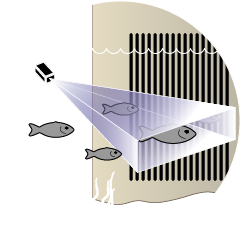Fish Impingement Monitoring
- Imaging sonar system for “video-like” clarity of fish activity and behaviour.
- Fish counts, swimming speed and direction easily measured.
- Operates day & night and in high turbidity. No light source required.
- Continuous logging and automated post-processing allows long-term monitoring.
- Compliant with EPA Clean Water Act § 316(b) monitoring requirements.
What is ARIS, DIDSON & Mesotech M3-HF?
ARIS (Adaptive Resolution Imaging Sonar), it’s predecessor, DIDSON (Dual-frequency IDentification SONar) and the new Kongsberg-Discovery M3-HF FlexView MBES have been referred to as “acoustic cameras” because of their near video-quality images they produce using very high frequency sound waves. These imaging sonar models can be deployed in shallow waters, where traditional echosounders have more difficulty, and they allow the user to visualize fish targets with near video quality below the water’s surface.
What can imaging sonars be used for?
ARIS, DIDSON and M3-HF (FlexView) have many applications in fisheries and aquatic science. They can be used for enumerating and measuring indivudual fish passing through streams, fish ladders, and other areas of interest and for identifying bottom features and habitat.
Using ARIS, DIDSON and M3-HF (FlexView), Milne Technologies has helped clients to monitor migratory fishes (including Lake Sturgeon, Salmon spc., Striped Bass, Eulachon (Smelt spc.) and river spawning Lake Whitefish) as well as view underwater nets to ensure proper deployment and to quantify "fish flux" and escapement rates.
Services that Milne Technologies provides related to imaging multibeam sonars
- Purchasing or leasing of appropriate equipment depending on project scope and objectives.
- On-site set-up and deployment of equipment and project maintenance.
- Develop scientifically rigorous study design in consulation with client.
- Detailed analysis of data including automated enumuration and measurement of fish targets.
- Written report including publication-quality methods, results and recomendations for future projects.


